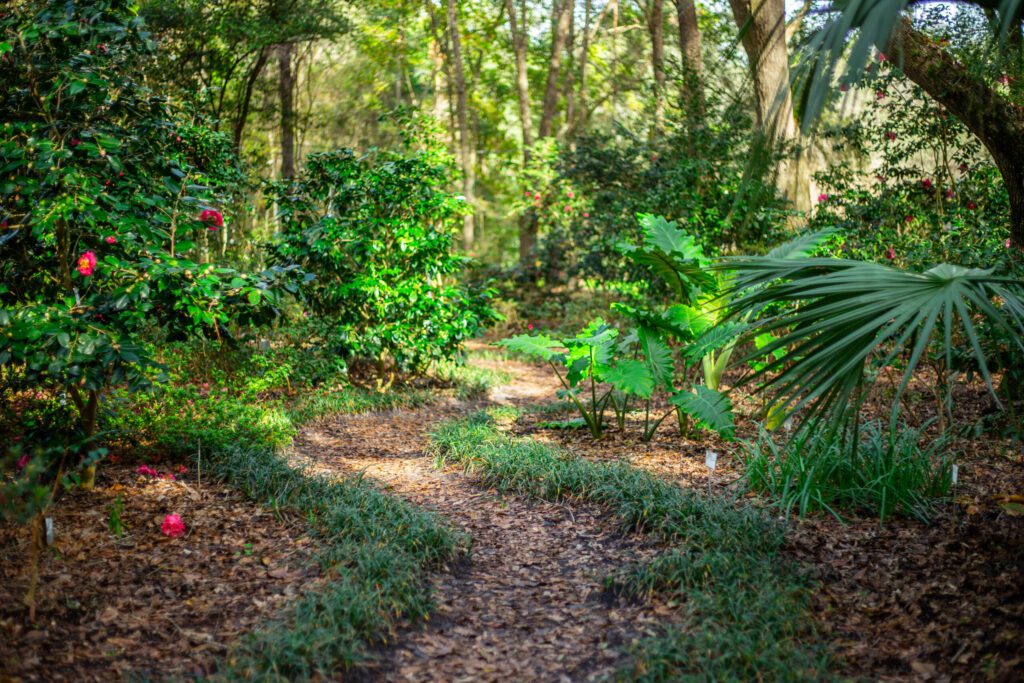Father’s Kanapaha Botanical Gardens Dream Blossoms Under Daughter’s Direction
by TIM CRAIG
In a way, Alexis Caffrey was raised into her role.
Caffrey, in her 11th year as director of Kanapaha Botanical Gardens in Gainesville, has had a front-row seat to the creation, development, and growth of the location into one of the premier show gardens in the Southeast.
Her journey started in 1977 when her father, the naturalist Donald Goodman — along with members of the North Florida Botanical Society — founded the Kanapaha Botanical Gardens with the idea of starting a botanical garden in Gainesville like Sarasota’s Marie Selby Gardens or Miami’s Fairchild Tropical Botanic Gardens.
In 1978, the group obtained a lease from Alachua County for 33 acres to begin development. Four years later, the group leased an additional 29 acres from the county to round out the gardens’ 62 acres.
As the daughter of Goodman, Caffrey grew up watching her father develop the gardens and eventually worked with him.
“My parents would pick me up from school and they’d drop me at the gardens,” she says. “I’ve always been involved, and this place is like a second home to me.”
When the gardens opened to the public in 1986, visitors walked a mile-long loop on the eastern portion of the gardens, while in the western part, there was a half-mile loop highlighted by a manmade water feature. Today, the gardens have 24 major collections, all arranged taxonomically.
“A botanical garden is kind of like a zoo for plants,” says Caffrey. “So we try to keep the plants together, organized down to the family level.”
Caffrey says they try to highlight the interactions plants have with their biotic and abiotic surroundings. “In our hummingbird garden, for instance, we grow a lot of red, pink, and orange colors that attract the hummingbirds,” she says. “On our butterfly hill, we have a lot of colors that attract as well.”
Kanapaha Gardens has the state’s largest public display of bamboos — including its signature premier stand of Chinese Royal bamboo — as well as the largest herb garden in the Southeast. But throughout the lush 62 acres, there are unexpected sights and sounds.
“I think a lot of people find the gardens more expansive than they thought it would be,” says Caffrey. “A lot of the time, when people first see the giant Victorian water lilies, they don’t expect it to be like that either.”
Part of the mission of Kanapaha Gardens is to grow unusual or endangered plants, as well as showcase plants that are new to the market.
In 2018, for example, Goodman — who, though retired, still helps tend the gardens — was able to grow a Franklinia alatamaha tree, better known as the Ben Franklin tree, to full bloom. The tree was discovered in 1776 by famed English naturalist William Bartram as he walked through present-day Paynes Prairie. The tree has not been found in the wild since 1803.
“This is the first time that people get to see some of these plants,” says Caffrey.
Caffrey points to the bulbine plant as an example of plants that are new to the market. The bulbine is native to Southern Africa. It is a bulbed-shaped plant that has proven to grow well in Florida. She’s currently attracted to the Gold Dust flower, a short, creeping annual flower that hugs the ground at under six inches and blooms profusely all summer long.
“I just fell in love with it,” she says. “We planted it throughout the gardens, and now we’re starting to see it spread.”
The advantage of a place like Kanapaha Gardens, according to Caffrey, is that it shows people the possibilities of what they can do in their own gardens.
“It’s nice to show people what can be grown in this area,” says Caffrey. “We encourage people to walk around and look at the light conditions. Most of the plants we grow are cold-hardy.”
Four years ago, the Kanapaha Gardens purchased six additional acres that it uses for special events parking. The gardens have become a premier wedding venue as well as host to other special events. In January and February is a bamboo sale. In March is North Central Florida’s premier horticultural event, the Spring Garden Festival. In the Fall, there is another Plant Sale and Orchid Show. It also hosts a Moonlight Walk, when the paths and meadows are illuminated by special laser lights and more than 1,500 luminaries. The gardens permit dogs on leashes, except during special events.
“I think this is a special place and I like to share it with everyone who comes for a visit,” says Caffrey. “The garden is at its most colorful in the summertime, in June, July, and August, but I personally like the fall when it cools off just a bit and there’s still a lot of blooming”

